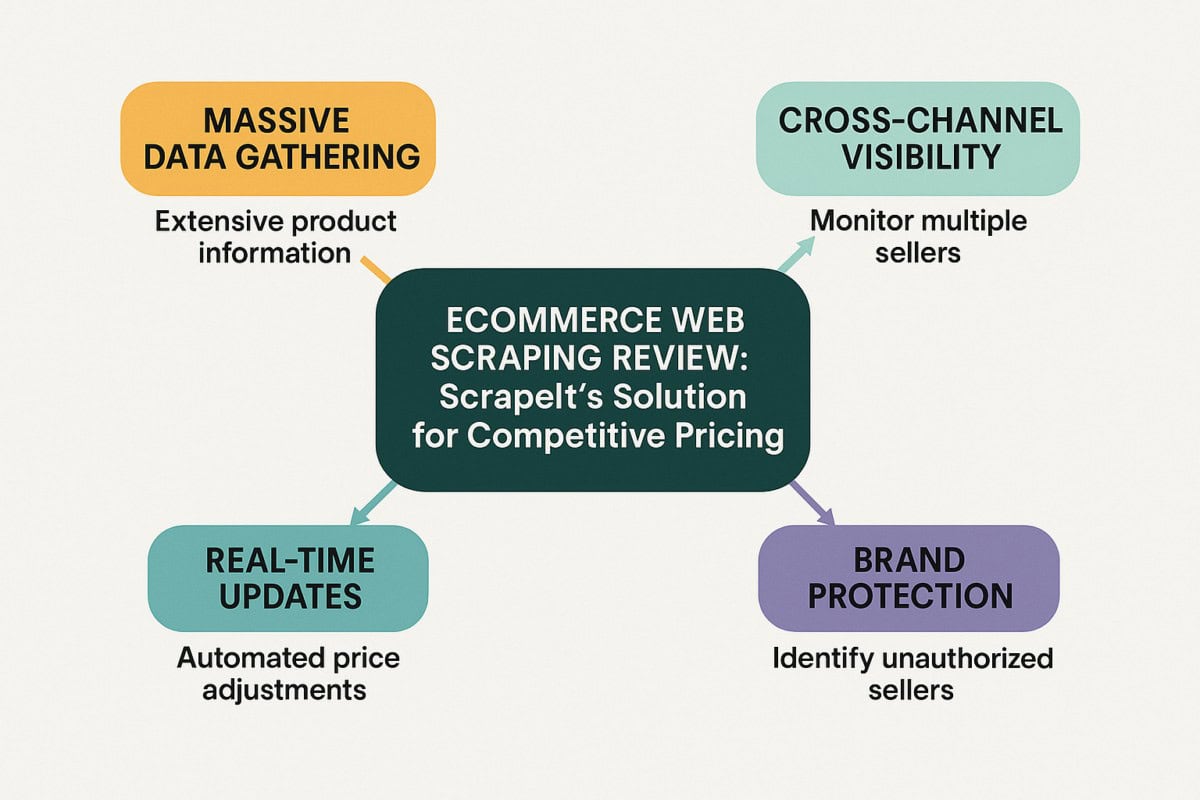
Visual breakdown of how ScrapeIt’s ecommerce web scraping empowers competitive pricing strategies through automation, data visibility, and brand control.
In the current ultra competitive atmosphere of online retail where pricing is a key factor that can turn your profits either way, the survival of businesses is at stake. The consumers, who have the power to assess multiple product displays in a matter of seconds, make it necessary for businesses to keep an eye on the market and respond in real time. The answer to this situation is ecommerce site scraping: automated product data collection and competitive analysis lead to implementing dynamic pricing strategies, covering brands, and discovering the market in a more profound way. In this article, we shall study how ScrapeIt’s web scraping services help in the competitive pricing workflows so that you can stay ahead of the competition.
Online retailing is riddled with the Pricing Conundrum
Even though they are digital retailers that get access to the world, they are still open to the harsh exposure of same prices to instant comparison. Crucial obstacles include the following:
- Price Undercutting: Competing sites have the power to lower their prices immediately after an algorithm detects a cheaper offer elsewhere.
- Data Overload: At large scales, it is impossible to manually track thousands of SKUs on various channels.
- Dynamic Market Conditions: Price benchmarks can change hourly due to seasonal promotions, supply shortages, and flash sales.
- Brand Protection Risks: Your official listings can be undermined by unauthorized resellers or counterfeit goods, which can erode the brand trust.
Selling companies can manage competition and profit by using the dynamic pricing model, which includes automatically changing prices by the instructions of the real-time market. According to the industry findings, firms implementing a rule-based pricing strategy gain an increase in the profit margin of as much as 25% and a rise in the conversion rate of 30%.¹ However, that data-driven flexibility can be achieved only when updates of competitor prices are not only timely but also accurate in real time.

The Importance of Ecommerce Web Scraping
Essentially, ecommerce web scraping is the process through which automated programs collect pricing, accessibility, and item features from retailer and marketplace websites. When it is together with analytics and pricing engines, this method can change raw HTML into applicable comprehension:
- Massive Data Gathering
The crawling bots run through millions of product pages iteratively—pulling SKU codes, price tags, discount rates, methods of delivery, and even user ratings. - No Programmable Comparative
Autonomous by-products or API limits, web scraping can be carried out on scheduling timeframes, that might sound like minutes, embrace the latest data to dynamic pricing engines - Cross-Channel Visibility
Monitor your direct competitors, marketplaces (like Amazon, eBay), and niche players in a unified dataset—eliminating blind spots. - Brand Protection
You’re able to track unauthorized resellers or counterfeit listings that pop up, triggering takedown requests or pricing actions. - Advanced Market Insights
When pricing trends are linked with product conclusions, client critiques, and levels of stock, it is possible to predict the market, and result in advertising and product development.
Retailers without proper scraping tools risk being blind to drawbacks such as missed wars on pricing, stockouts, or increases in demand. Yet, implementing and sustaining a self-scraping base has its own problems. IP blocking, captchas, rotating user agents, and proxy management are all the things that make it complicated.
ScrapeIt Surf’s End-to-End Scraping Solution
ScrapeIt sets up the entire web scraping service for ecommerce, taking care of infrastructure to data delivery completely.
| Feature | What It Does | Benefit |
| Proxy Management | Residential and backconnect proxies rotate IPs | Avoid blocks, maintain anonymity |
| Captcha Solving | Automated detection and bypass | Uninterrupted scraping, even under protections |
| Infrastructure Scaling | Auto‑scaled servers adapt to volume spikes | Consistent performance during sales or events |
| Data Normalization | Cleans, structures, and deduplicates raw data | Ready‑to‑use product data for analysis |
| Real‑Time Updates | Configurable schedules (minutes/hours/daily) | Power dynamic pricing and monitoring |
| Dashboard & Alerts | Custom dashboards, email/SMS triggers on price shifts | Instant awareness of critical changes |
| API & Data Feeds | JSON/CSV exports and RESTful API endpoints | Seamless integration with pricing engines |
A Real-Life Example of How It Works
- Target Definition: The first step is to create a list of product pages or competitor domains that you want to keep an eye on.
- Schedule Configuration: The next step is to choose how often you would like the updates to be done. You can configure it to be done every 5 minutes if it is a high-volume SKU or once an hour if it is a relatively stable category.
- Alerts and Thresholds Setting: If you want to be notified, for instance, when a competitor’s price drops more than 3%, inventory goes below 10 units, or your listing differs from the market average, you can set these thresholds and alerts.
- Data Integration: Take structured feeds directly into your pricing engine, BI dashboard, or ERP.
This is a fully managed automation backed by no in-house pool of proxies, headless browser orchestration, or captcha subscription scripts. Instead, your staff works on decision-making, while ScrapeIt ensures data collection is always on, scalable, uninterrupted.
Boosting Revenue with Automatic Pricing Intelligence
For instance, let us look at a case scenario of automatic dynamic pricing:
| Competitor A Price | Competitor B Price | Your Current Price | Action |
| $99.99 | $104.99 | $102.50 | Lower price to $98.99 for edge in 5‑minute window |
| $95.00 | $98.50 | $96.00 | Match $95.00 if ROI potential remains above 20% |
| Out of Stock | $110.00 | $105.00 | Raise price 5% until back in stock |
- Competitor Analysis: ScrapeIt discovered that Competitor A has slashed their price from $102.50 to $99.99.
- Automated Rule Trigger: Your rule engine receives the feed, checks ROI thresholds and recommends setting your price at $98.99.
- Real‑Time Update: Your storefront updates in seconds to catch those shoppers who are sensitive to the price before competitors come up with any reaction.
By continuously running this loop, you will be able to remain in the lead without the requirement of human manipulation. The additional benefit of gathering real-time stock level data is that you can avoid “lost sales” for instance due to out-of-stock situations or restocking scarce items at a higher margin.

Go Beyond Pricing: Secure Your Brand & Gain Market Insights
Typically, rivalry rates tends to be the first thing we look at, but also the ScrapeIt platform provides assistance to our users:
Brand Security: Track down unauthorized listings, pseudo-manufacturers, or resellers involved in the gray market. ScrapeIt presents any item that is against your pricing policy or brand guidelines by flagging non-compliance which allows you to take either legal or market place actions.
Market Insights: After scraping reviews, ratings, and product descriptions, you can use this data to feed the sentiment analysis engines. Get info on which features are the best substitutes for the problems consumers have, and get convinced of the product with low features or benefits.
Data Enrichment: Collect your competitors’ specifications such as sizes, materials, and bundling options for the purpose of ensuring that your listings are as attractive and comprehensive as possible.
Smart tools thicken your vision of the online retail ecosystem and show you the potential that goes far beyond simple price corrections.
Using ScrapeIt: A Straightforward Guide Email
Onboarding & Discovery
– Kickoff meeting to map your SKU universe, target competitors, and key performance indicators (KPIs).
– Spot high-priority categories where dynamic pricing will drive rapid gains.
Configuration & Testing
– Scraping targets (URLs, CSS/XPath selectors) need to be defined.
– Set up proxy pools, captcha solvers, and request headers.
– Run tests and check data accuracy and completeness.
Integration
– Carry out RESTful API calls or scheduled CSV exports.
– Feed it to your existing pricing engine (e.g., Pricemoov, Revionics) or BI tools (Tableau, Power BI).
Rule Engine Deployment
– Define thresholds for price adjustments and ROI rules.
– Automation of alerts for margin erosion, price wars, or stock anomalies.
Monitoring & Optimization
– Use ScrapeIt’s dashboard to monitor scrape success rates, latency, and data freshness.
– Tuning the times and proxies as required for changing target sites.
Scaling & Expansion
– Widen the scrape range by attaching it to other marketplaces (e.g., Walmart Marketplace, Alibaba).
– Bring in review and social media scraping for more comprehensive market insights

Real-World Impact: Return on Investment & Business Results
ScrapeIt’s ecommerce web scraping is a technology that has been embraced by companies which have seen the following:
- 20-30% Reduction in Price Matching Time: Automated detection and execution reduce reaction times from hours to minutes.
- 15–25% Increase in Average Order Value (AOV): Real‑time pricing rules take advantage of demand spikes and signals of scarcity.
- 40-50% Decrease in Manual Work: Teams can distribute the resources on strategic analysis instead of data gathering.
- Brand Integrity Boosted: The proactive detection of unauthorized sellers helps maintain customer trust and market positioning.
By providing with the regular competitor analysis and dynamic product data feeds, the ScrapeIt’s solution does not only enhance the smarter pricing but also it empowers the larger digital transformation initiatives across marketing, sales and operations.
Final Statement
With the importance of every single cent—and every single second—of one’s time, the web scraping of e-commerce has become the basic tool for any online retailer that is serious about the competitive pricing, automation, and protection of its brand. The fully managed service of ScrapeIt is devoid of the technical hurdles of the proxy management, captcha solving, and infrastructure scaling, and it delivers clean, normalized data and real-time updates directly to your pricing engine.
Regardless of whether you are a small merchant or a multinational enterprise, ScrapeIt provides you with the necessary data to elude your competitors, keep your customers satisfied, and protect your brand. Reshape your pricing strategy now with ScrapeIt’s eCommerce scraping services https://www.scrapeit.io/scrape-ecommerce-website and convert raw market data into your main weapon against competitors.







